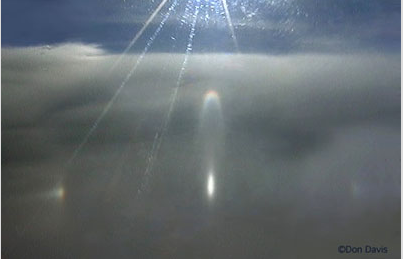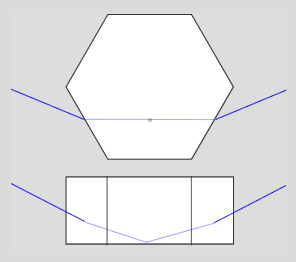Subparhelia
Subparhelia: A Fascinating Atmospheric Optical Phenomenon
When it comes to atmospheric optics, there are countless mesmerizing phenomena that can occur in the sky. One such phenomenon is subparhelia, also known as the "mock suns." Subparhelia are often seen as downward slanting spots of light located to the left and right of the subsun. Additionally, there may be a lower tangent arc positioned above the subparhelia but still below the horizon. These unique formations provide a captivating spectacle for those fortunate enough to witness them.
Subparhelia are created through the interaction of sunlight with ice crystals present in the atmosphere. Specifically, these crystals are oriented plates that scatter sunlight in a particular manner, resulting in the formation of subparhelia. Rays of sunlight enter and exit these plate crystals through side faces that are inclined at an angle of 60 degrees to each other. Unlike ordinary parhelion rays, subparhelia rays undergo total internal reflection by the lower horizontal face of the crystal. As a result, the subparhelia appear to be located below the horizon.
It is important to note that subparhelia are not exact mirror images of parhelia due to refraction effects within the ice crystals. The refraction alters the path of light as it passes through the crystals, leading to subtle variations in the appearance of these atmospheric phenomena. In some cases, multiple scattering from clouds of ice crystals can also contribute to the formation of subparhelia, although it is not necessary to invoke this mechanism to explain their occurrence.
To further understand the nature of subparhelia, simulations have been conducted using specialized software called HaloSim. By utilizing a combination of oriented plates for the subparhelia and singly oriented columns for the tangent arc, researchers have been able to replicate the appearance and position of these optical phenomena. These simulations provide valuable insights into the underlying physics and help refine our understanding of subparhelia.
In order to determine the solar altitude associated with a particular occurrence of subparhelia, the position and shape of the tangent arc are analyzed. The lower tangent arc, located above the subparhelia but still below the horizon, serves as a reference point. By examining the relationship between the tangent arc and the subhorizon arcs, researchers can calculate the solar altitude with a high degree of accuracy. This information allows for a deeper understanding of the atmospheric conditions that give rise to subparhelia.
The captivating nature of subparhelia has caught the attention of both scientists and artists alike. Space artist Don Davis, known for his stunning depictions of celestial scenes, captured the beauty of subparhelia in his photographs. These images showcase the radiating streaks of sunlight scattered by scratches on an aircraft window, resulting in a striking visual display. By bringing together science and art, these photographs provide a unique perspective on the wonders of atmospheric optics.
In conclusion, subparhelia are a fascinating atmospheric optical phenomenon that adds to the allure of our skies. Created through the interaction of sunlight with ice crystals, these downward slanting spots of light offer a captivating sight for those lucky enough to witness them. Through simulations and analysis, researchers have gained valuable insights into the physics behind subparhelia, shedding light on their formation and behavior. As we continue to explore and unravel the mysteries of atmospheric optics, phenomena like subparhelia remind us of the intricate beauty that surrounds us in the natural world.


Subparhelia, subsun and lower tangent arc. Photographed by space artist Don Davis. The radiating streaks are sunlight scattered by scratches on the aircraft window.
The downward slanting subparhelia are to left and right of the subsun. Above it, but still below the horizon, is a lower tangent arc. The tangent arc shape and position relative to the subhorizon arcs allowed the solar altitude to be determined as 18.5�.
The matching HaloSim simulation for this altitude used a mixture of oriented plates for the subparhelia and singly oriented columns for the tangent arc.
The inset shows the complete parhelia and subparhelia. They are not exact mirror images because of refraction effects within the crystals.
Image �Don Davis, reproduced with permission.

Subparhelia ray paths. Rays enter and leave oriented plate crystals through side faces inclined at 60� to each other. They differ from ordinary parhelion rays in that they are totally internally reflected by the lower horizontal face. They leave the crystal in an upwards direction and so the subparhelia appear to be below the horizon.
These reflections are quite sufficient to explain subparhelia. It is not necessary to invoke multiple scattering from clouds of ice crystals.
Note: this article has been automatically converted from the old site and may not appear as intended. You can find the original article here.
Reference Atmospheric Optics
If you use any of the definitions, information, or data presented on Atmospheric Optics, please copy the link or reference below to properly credit us as the reference source. Thank you!
-
<a href="https://atoptics.co.uk/blog/subparhelia/">Subparhelia</a>
-
"Subparhelia". Atmospheric Optics. Accessed on December 21, 2024. https://atoptics.co.uk/blog/subparhelia/.
-
"Subparhelia". Atmospheric Optics, https://atoptics.co.uk/blog/subparhelia/. Accessed 21 December, 2024
-
Subparhelia. Atmospheric Optics. Retrieved from https://atoptics.co.uk/blog/subparhelia/.